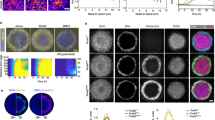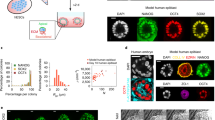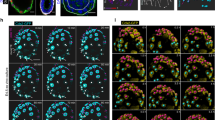Abstract
Shortly after implantation the mouse embryo comprises three tissue layers. The founder tissue of the embryo proper, the epiblast, forms a radially symmetric cup of epithelial cells that grows in close apposition to the extra-embryonic ectoderm and the visceral endoderm. This simple cylindrical structure exhibits a distinct molecular pattern along its proximal–distal axis1. The anterior–posterior axis of the embryo is positioned later by coordinated cell movements that rotate the pre-existing proximal–distal axis2,3,4,5. The transforming growth factor-β family member Nodal is known to be required for formation of the anterior–posterior axis6. Here we show that signals from the epiblast are responsible for the initiation of proximal–distal polarity. Nodal acts to promote posterior cell fates in the epiblast and to maintain molecular pattern in the adjacent extra-embryonic ectoderm. Both of these functions are independent of Smad2. Moreover, Nodal signals from the epiblast also pattern the visceral endoderm by activating the Smad2-dependent pathway required for specification of anterior identity in overlying epiblast cells. Our experiments show that proximal–distal and subsequent anterior–posterior polarity of the pregastrulation embryo result from reciprocal cell–cell interactions between the epiblast and the two extra-embryonic tissues.
This is a preview of subscription content, access via your institution
Access options
Subscribe to this journal
Receive 51 print issues and online access
$199.00 per year
only $3.90 per issue
Buy this article
- Purchase on Springer Link
- Instant access to full article PDF
Prices may be subject to local taxes which are calculated during checkout




Similar content being viewed by others
References
Beddington, R. S. P. & Robertson, E. J. Axis development and early asymmetry in mammals. Cell 96, 195–209 (1999).
Thomas, P. & Beddington, R. S. P. Anterior primitive endoderm may be responsible for patterning the anterior neural plate in the mouse embryo. Curr. Biol. 6, 1487–1496 (1996).
Ding, J. et al. Cripto is required for correct orientation of the anterior–posterior axis in the mouse embryo. Nature 395, 702–707 (1998).
Rhinn, M. et al. Sequential roles for Otx2 in visceral endoderm and neuroectoderm for forebrain and midbrain induction and specification. Development 125, 845–856 (1998).
Kimura, C. et al. Visceral endoderm mediates forebrain development by suppressing posteriorizing signals. Dev. Biol. 225, 304–321 (2000).
Schier, A. F. & Shen, M. M. Nodal signalling in vertebrate development. Nature 403, 385–389 (2000).
Varlet, I., Collignon, J. & Robertson, E. J. Nodal expression in the primitive endoderm is required for specification of the anterior axis during mouse gastrulation. Development 124, 1033–1044 (1997).
Zhou, X., Sasaki, H., Lowe, L., Hogan, B. L. & Kuehn, M. R. Nodal is a novel TGF-beta-like gene expressed in the mouse node during gastrulation. Nature 361, 543–547 (1993).
Conlon, F. L. et al. A primary requirement for Nodal in the formation and maintenance of the primitive streak in the mouse. Development 120, 1919–1928 (1994).
Kumar, A. et al. Nodal signaling uses activin and transforming growth factor-β receptor-regulated Smads. J. Biol. Chem. 276, 656–661 (2000).
Waldrip, W. R., Bikoff, E. K., Hoodless, P. A., Wrana, J. L. & Robertson, E. J. Smad2 signaling in extra-embryonic tissues determines anterior–posterior polarity of the early mouse embryo. Cell 92, 797–808 (1998).
Liu, P. et al. Requirement for Wnt3 in vertebrate axis formation. Nature Genet. 22, 361–365 (1999).
Russ, A. P. et al. Eomesodermin is required for mouse trophoblast development and mesoderm formation. Nature 404, 95–99 (2000).
Meno, C. et al. Mouse Lefty2 and zebrafish antivin are feedback inhibitors of Nodal signaling during vertebrate gastrulation. Mol. Cell 4, 287–298 (1999).
Rosner, M. H. et al. A POU-domain transcription factor in early stem cells and germ cells of the mammalian embryo. Nature 345, 686–692 (1990).
Poirier, F., Timmons, P. M., Chan, C. T., Guenet, J. L. & Rigby, P. W. Expression of the L14 lectin during mouse embryogenesis suggests multiple roles during pre- and post-implantation development. Development 115, 143–155 (1992).
Thomas, P. Q., Brown, A. & Beddington, R. S. P. Hex: a homeobox gene revealing peri-implantation asymmetry in the mouse embryo and an early transient marker of endothelial cell precursors. Development 125, 85–94 (1998).
Perea-Gomez, A., Shawlot, W., Sasaki, H., Behringer, R. R. & Ang, S. HNF3beta and Lim1 interact in the visceral endoderm to regulate primitive streak formation and anterior–posterior polarity in the mouse embryo. Development 126, 4499–4511 (1999).
Belo, J. A. et al. Cerberus-like is a secreted factor with neutralizing activity expressed in the anterior primitive endoderm of the mouse gastrula. Mech. Dev. 68, 45–57 (1997).
Ang, S. L., Conlon, R. A., Jin, O. & Rossant, J. Positive and negative signals from mesoderm regulate the expression of mouse Otx2 in ectoderm explants. Development 120, 2979–2989 (1994).
Poirier, F. et al. The murine H19 gene is activated during embryonic stem cell differentiation in vitro and at the time of implantation in the developing embryo. Development 113, 1105–1114 (1991).
Blum, M. et al. Gastrulation in the mouse: the role of the homeobox gene goosecoid. Cell 69, 1097–1106 (1992).
Adachi, H. et al. Determination of left/right asymmetric expression of Nodal by a left side-specific enhancer with sequence similarity to a lefty-2 enhancer. Genes Dev. 13, 1589–1600 (1999).
Norris, D. P. & Robertson, E. J. Asymmetric and node-specific Nodal expression patterns are controlled by two distinct cis-acting regulatory elements. Genes Dev. 13, 1575–1588 (1999).
Whitman, M. Smads and early developmental signaling by the TGFβ superfamily. Genes Dev. 12, 2445–2462 (1998).
Saijoh, Y. et al. Left–right asymmetric expression of Lefty2 and Nodal is induced by a signaling pathway that includes the transcription factor FAST2. Mol. Cell 5, 35–47 (2000).
Collignon, J., Varlet, I. & Robertson, E. J. Relationship between asymmetric Nodal expression and the direction of embryonic turning. Nature 381, 155–158 (1996).
Tremblay, K. D., Hoodless, P. A., Bikoff, E. K. & Robertson, E. J. Formation of the definitive endoderm in mouse is a Smad2-dependent process. Development 127, 3079–3090 (2000).
Acampora, D. et al. Visceral endoderm-restricted translation of Otx1 mediates recovery of Otx2 requirements for specification of anterior neural plate and normal gastrulation. Development 125, 5091–5104 (1998).
Gritsman, K. et al. The EGF-CFC protein one-eyed pinhead is essential for Nodal signaling. Cell 97, 121–132 (1999).
Acknowledgements
We thank E. Bikoff, P. Hoodless, R. Dunn and K. Tremblay for helpful discussions and comments on the manuscript; J. Wrana and P. Hoodless for permission to cite unpublished work; and P. Lewko and J. Rocca for animal care. This work was funded by the NIH and supported by a postdoctoral fellowship from the Wellcome Trust (J.B.) and a Charles A. King Trust fellowship (D.P.N.). This paper is dedicated to the memory of Rosa Beddington, our dear friend and colleague, who died on 18 May 2001.
Author information
Authors and Affiliations
Corresponding author
Supplementary Information

Figure 1
(JPG 502 KB)
Nodal deficient embryos contain abundant extra-embryonic ectoderm. Whole mount in situ hybridisation (a-d) and bgal (e, f) analysis of early gastrulation control (c, e) or Nodal mutant (a, b, d, e) embryos. L1416 is expressed in the extra-embryonic ectoderm of Nodal mutants (a). Red line indicates plane of section shown in b. Longitudinal sections taken through 6.5dpc embryos (c-f). Otx2 was used to clearly differentiate the epiblast, which expresses Otx2 (c), from the extra-embryonic ectoderm (outlined with dotted line). In the Nodal mutant (d) the extra-embryonic ectoderm is clearly a distinct tissue population from the epiblast (outlined with dotted line). Similarly, the NodallacZ allele was used to mark the distal epiblast (e), adjacent to this tissue is the extra-embryonic ectoderm (e, f).
Rights and permissions
About this article
Cite this article
Brennan, J., Lu, C., Norris, D. et al. Nodal signalling in the epiblast patterns the early mouse embryo. Nature 411, 965–969 (2001). https://doi.org/10.1038/35082103
Received:
Accepted:
Issue Date:
DOI: https://doi.org/10.1038/35082103
This article is cited by
-
Epithelial disruption drives mesendoderm differentiation in human pluripotent stem cells by enabling TGF-β protein sensing
Nature Communications (2023)
-
Nodal is a short-range morphogen with activity that spreads through a relay mechanism in human gastruloids
Nature Communications (2022)
-
A Nodal enhanced micropeptide NEMEP regulates glucose uptake during mesendoderm differentiation of embryonic stem cells
Nature Communications (2022)
-
Generation of extracellular morphogen gradients: the case for diffusion
Nature Reviews Genetics (2021)
-
Basement membrane remodelling regulates mouse embryogenesis
Nature (2020)
Comments
By submitting a comment you agree to abide by our Terms and Community Guidelines. If you find something abusive or that does not comply with our terms or guidelines please flag it as inappropriate.



